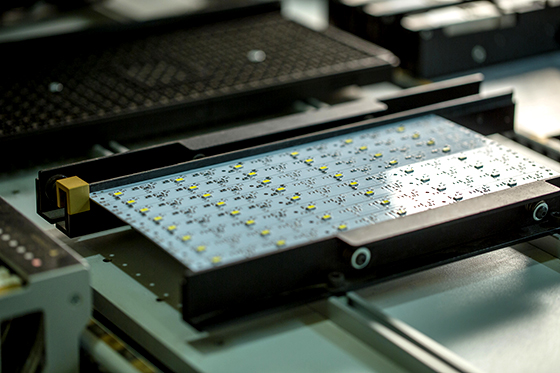As automobile intelligence continues to advance, intelligent high-beam systems have become one of the key technologies for improving night-time driving safety and comfort. Traditional high beams rely on manual switching, whereas intelligent high-beams systems can automatically adjust the brightness and range of the light beam according to road conditions, effectively preventing glare for oncoming drivers and pedestrians. Automotive PCBs play a vital role in this process, serving as the core component for control and signal transmission, ensuring the stable operation of intelligent lighting systems.
HoYoGo, as a professional and experienced automotive PCB manufacturer, provides high-quality PCB products to the global automotive industry. Automotive PCBs account for 49% of our total production output. The following sections will explain in detail the applications of automotive PCBs in intelligent high-beam systems.

1. Basic Functions of the Intelligent High-Beam System
The intelligent high-beam system operates through the coordinated work of sensors, cameras, and an electronic control unit (ECU), enabling automatic adjustment of the beam’s direction and brightness. The system can identify vehicles, pedestrians, and road signs in real time, and dynamically adjust the light distribution based on the detected information. This helps prevent glare while ensuring the driver maintains a clear view during nighttime driving. The entire process relies on precise and efficient electronic control, while the automotive PCB serves as an indispensable core component of the intelligent lighting system.
2. The Role of Automotive PCBs in Intelligent High-Beam Systems
1) Power Management
Intelligent high-beam systems are typically composed of multiple LED light sources and high-power driver circuits, which place extremely high demands on power stability. Automotive PCBs, through optimized circuit layout and current distribution design, can achieve efficient and stable power management even within limited space, ensuring that each LED module operates reliably under various working conditions.
2) Signal Processing
Intelligent high-beam systems rely on cameras and sensors to capture real-time road information. The collected image and environmental data must be analyzed and responded to within milliseconds. Automotive PCBs integrate high-speed signal processing chips and multilayer routing structures, enabling stable data transmission and signal conversion. They rapidly transform image signals into control commands that drive precise light adjustments, achieving real-time responsiveness in intelligent lighting systems.
3) Thermal Management and Heat Dissipation
Although LED light sources provide high-brightness illumination, they generate significant heat during operation. Excessive temperature can affect system stability and shorten component lifespan. Therefore, automotive PCBs must feature excellent thermal management and heat dissipation design. By adopting high thermal-conductivity materials and optimizing circuit layout and component placement, automotive PCBs can efficiently dissipate heat, ensuring that the intelligent high-beam system maintains stable performance and reliable output during long-term operation.
4) Automatic Adjustment and Intelligent Algorithms
The automatic adjustment of intelligent high beams depends not only on hardware performance but also on precise software algorithms. The microprocessor embedded in the automotive PCB interacts in real time with the vehicle’s Electronic Control Unit (ECU) to execute complex lighting algorithms. Based on road conditions, vehicle speed, and ambient light, the system dynamically adjusts light output, achieving intelligent and automated illumination control that enhances driving safety and comfort during nighttime operation.
3. Design Challenges of Automotive PCBs
1) High-Density Integration
The intelligent high-beam system has limited installation space yet requires the integration of multiple functional modules. This imposes stringent requirements on the layout and design of automotive PCBs. Through high-density routing and precise electrical isolation design, PCBs must not only ensure efficient circuit operation, but also avoid overheating and signal interference, thus ensuring stable system performance.
2) Environmental Resistance
Automobiles operate in complex and variable environments. Especially under different climates and road conditions, the PCB used in intelligent high-beam systems must demonstrate excellent durability and anti-interference capability. A high-quality automotive PCB design should feature vibration resistance, moisture and dust protection, and high-temperature endurance, ensuring stable operation even under extreme conditions.
3) Multilayer Design
As intelligent lighting functions continue to advance, automotive PCBs commonly adopt multilayer structures to maintain signal integrity and reduce electromagnetic interference (EMI). Such multilayer PCBs demand higher precision in design, layer stacking, and manufacturing processes, serving as a critical foundation for achieving high-performance intelligent high-beam systems.
4. Future Outlook
With the continuous advancement of autonomous driving technology, intelligent high beams will no longer serve merely as lighting tools, but will become an integral part of the autonomous driving system. In the future, automotive PCBs will need to support more complex light-sensing and adjustment algorithms, and even collaborate with other onboard sensors to enhance overall traffic safety. In addition, as vehicle-to-everything (V2X) technologies continue to develop, the interactivity and intelligence of high-beam systems will be further enhanced, while the functions of automotive PCBs will become increasingly diversified.
HoYoGo is a professional and reliable automotive PCB manufacturer certified under ISO 9001, ISO 14001, and IATF 16949 international quality management systems. The company provides one-stop services covering every stage of automotive electronics manufacturing, from upstream electronic component sourcing, PCB fabrication and processing, SMT assembly, and PCBA testing to final product assembly. All of our products strictly comply with IPC-A-600-H and IPC-6012 acceptance standards. Every inspection step is rigorously controlled, and we consistently maintain high manufacturing standards to be a trusted partner for our customers.